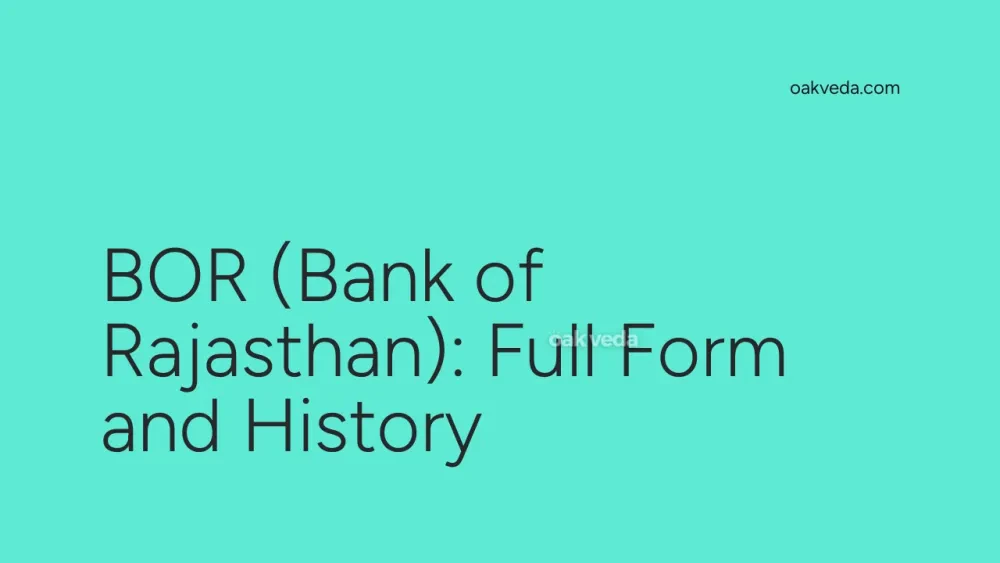
What is the Full Form of BOR?
The full form of BOR is Bank of Rajasthan. This abbreviation represents a former private sector bank in India that played a significant role in the country's banking landscape for over six decades.
What is Bank of Rajasthan?
Bank of Rajasthan, commonly known as BOR, was a private sector bank that operated in India from 1943 to 2010. It was headquartered in Udaipur, Rajasthan, with its central office located in Jaipur. The bank served customers across 24 states through its extensive network of 463 branches, with a strong presence in Rajasthan, where it had 294 branches.
Origin and Development of Bank of Rajasthan
The Bank of Rajasthan has a rich history dating back to the pre-independence era of India. Here's a brief overview of its origin and development:
- Founding: BOR was established in 1943 in Udaipur, Rajasthan, with an initial capital of Rs. 10 lakh (1 million rupees).
- Founding Members: The bank was founded by an eminent industrialist, Seth Shri Govind Ram Seksaria, who became its first chairman. The first general manager was Late Shri Dwarka Prasad Gupta.
- Scheduled Bank Status: In 1948, BOR was categorized as a Scheduled Bank, granting it certain privileges and responsibilities under the Reserve Bank of India Act.
- Rural Banking Initiative: On January 26, 1983, BOR established a rural bank called Mewar Anchlik Gramin Bank in the Udaipur District of Rajasthan, showcasing its commitment to rural development.
How did Bank of Rajasthan operate?
Bank of Rajasthan operated as a full-service commercial bank, offering a wide range of banking products and services to its customers. These included:
- Savings and current accounts
- Fixed deposits
- Loans and advances
- Foreign exchange services
- Remittance facilities
- Rural and agricultural banking services
The bank's strong presence in Rajasthan allowed it to cater to the specific needs of the local population while also serving customers across India through its pan-India branch network.
Functions of Bank of Rajasthan
As a private sector bank, BOR performed several crucial functions in the Indian banking ecosystem:
- Mobilizing Savings: BOR encouraged savings by offering various deposit schemes to individuals and businesses.
- Credit Disbursement: The bank provided loans and advances to different sectors of the economy, supporting economic growth.
- Rural Development: Through its rural banking initiatives, BOR played a role in promoting financial inclusion in rural areas.
- Supporting Local Businesses: With its strong presence in Rajasthan, the bank was well-positioned to support local businesses and industries.
- Foreign Exchange Services: BOR facilitated international trade by offering foreign exchange services to its customers.
Merger with ICICI Bank
The most significant event in the history of Bank of Rajasthan was its merger with ICICI Bank in 2010. This merger marked the end of BOR's independent existence and had a substantial impact on the Indian banking sector.
Key Points of the Merger:
- Merger Value: ICICI Bank acquired BOR for approximately Rs. 30 billion.
- Share Conversion: Each 118 shares of BOR were converted into 25 shares of ICICI Bank (dated October 12, 1998).
- Regulatory Concerns: The merger was partly driven by the Reserve Bank of India's (RBI) concerns about BOR's promoters not reducing their holdings in the bank as per regulatory requirements.
- Branch Network Expansion: The merger allowed ICICI Bank to significantly expand its branch network, especially in Rajasthan.
Impact of the BOR-ICICI Bank Merger
The merger of Bank of Rajasthan with ICICI Bank had several implications:
- Consolidation in Banking Sector: It was part of the broader trend of consolidation in the Indian banking industry.
- Enhanced Customer Base: ICICI Bank gained access to BOR's extensive customer base, particularly in Rajasthan.
- Improved Efficiency: The merger aimed to bring operational efficiencies and better services to former BOR customers.
- Regulatory Compliance: The merger addressed RBI's concerns regarding BOR's ownership structure.
FAQs on BOR Full Form
-
What is the full form of BOR in banking? The full form of BOR in banking is Bank of Rajasthan.
-
When was Bank of Rajasthan established? Bank of Rajasthan was established in 1943 in Udaipur, Rajasthan.
-
Is Bank of Rajasthan still operational? No, Bank of Rajasthan merged with ICICI Bank in 2010 and ceased to exist as an independent entity.
-
Why did Bank of Rajasthan merge with ICICI Bank? The merger was driven by regulatory concerns and was part of the consolidation trend in the Indian banking sector.
-
How many branches did Bank of Rajasthan have before the merger? Bank of Rajasthan had 463 branches across 24 states in India, with 294 branches in Rajasthan alone.
In conclusion, the Bank of Rajasthan (BOR) played a significant role in India's banking sector for over 60 years before its merger with ICICI Bank. Its legacy continues to influence the banking landscape in Rajasthan and beyond, serving as a reminder of the evolving nature of the Indian financial sector.
You may be interested in:
- AMIE (Associate Member of the Institution of Engineers)
- NTPC (National Thermal Power Corporation)
- IB (Intelligence Bureau): India's Internal Intelligence Agency
- FDI (Foreign Direct Investment): Full Form Explained
- GUI (Graphical User Interface): Full Form and Explained
- SIT (Special Investigation Team): Full Form Explained

